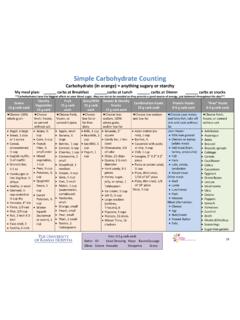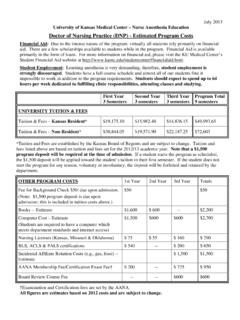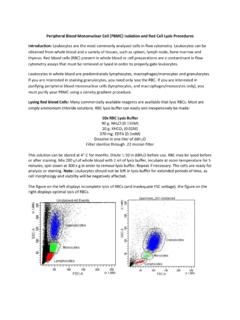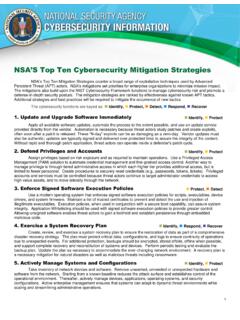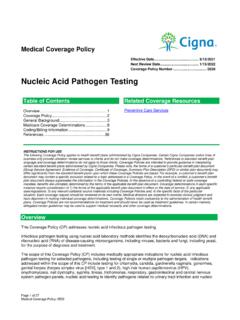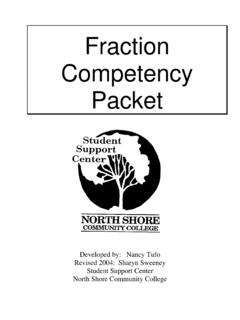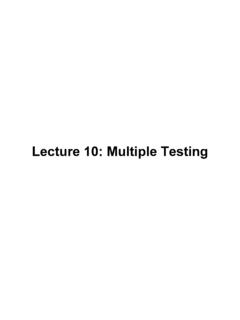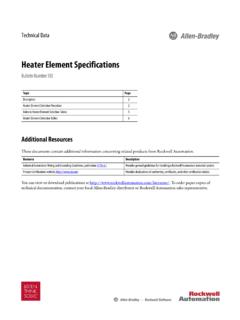Transcription of MANUAL MUSCLE TESTING (MMT)
1 MANUAL MUSCLE TESTING (MMT) MANUAL MUSCLE TESTING 16 MUSCLE groups/ motions will be tested (not individual muscles ). 14 of these are tested bilaterally. Grading will be based on the isometric Break test. It is essential that a grade of 3 be established before proceeding to application of resistance for grades above 3 or to alternate gravity minimized tests for grades below 3. MUSCLE Group Abbreviation Shoulder abductors SA Elbow flexors EF Wrist extensors WE Wrist flexors WF Common finger extensors CFE Thumb flexors TF Hip flexors HF Knee extensors KE Ankle dorsiflexors AD Hip abductors HAB Hip adductors HAD Elbow extensors EE Shoulder external rotators SER Hip extensors HE Knee flexors KF Ankle plantar flexors AP Neck flexion NF Neck extension NE The criteria for assigning specific grades are as follows.
2 Grade Criteria 5 Normal strength 5- Uncertain MUSCLE weakness 4+ Ability to move through full range of motion and hold against strong pressure 4 Ability to move through full range of motion and hold against moderate pressure 4- Ability to move through full range of motion and hold against slight pressure; or breaks abruptly with pressure 3 Ability to move through full range of motion against gravity 3- Ability to move through partial range of motion against gravity 2 Ability to move through any range of motion only with gravity eliminated 1 A flicker of movement is seen or felt in the MUSCLE 0 No contraction palpable For each test: Explain or demonstrate the movement that is required of the patient.
3 Ask the patient to perform the movement through the full range against gravity. If the patient does not perform or is unable to perform the complete movement, check for these limiting factors : o Understanding of the required task o Availability of the appropriate range of motion - limitations may be due to soft tissue. o Weakness Based on the limiting factor(s): o instruct and demonstrate again o decide if joint restriction is affecting the performance o repeat the test using the alternative gravity eliminated position If the patient completes the movement through full available range against gravity, place the joint at the appropriate angle and apply resistance gradually.
4 Appropriate feedback and encouragement will generate best effort on the part of the patient. Grade according to criteria described. If the patient experiences pain, cramps, or spasms during the TESTING , the clinical evaluator must determine whether the patient feels that he/she is able to give his best effort in spite of his discomfort. If yes, continue the TESTING but note under comments that the patient complained of pain. If the patient feels that discomfort prohibits him from giving a maximal effort, do not test that MUSCLE and code appropriately. The precise order of TESTING , in terms of whether the evaluator should test R/L, or complete one side in each position is left to the discretion of the CE.
5 However, it is important that the evaluator always be on the same side as the MUSCLE being tested. NOTE: It is necessary that the TESTING room allows for space all around the table and that the table is placed away from a wall. Certain muscles can be graded from 0-5 in one position only. For other muscles , the first TESTING position will indicate a grading range of 3- to 5. If the MUSCLE cannot be graded in this range, then it will need to be tested again in an alternate position. A. POSITION I: SITTING Seat patient comfortably on the examination table with shoes off and feet unsupported. The edge of the examining table should support the patient s thigh to a level proximal to the knee joint.
6 The following tests are performed in the sitting position: Shoulder Abduction (3- thru 5) 1. Ask patient to abduct the shoulder as much as they are able to with the elbow extended. If patient able to abduct greater than 90 degrees, ask the patient to position the shoulder to 90 with the elbow flexed and the forearm pronated. 2. Provide stabilization proximal to the shoulder or on the opposite shoulder to prevent any tendency to lean in the opposite direction. 3. With shoulder in 90o of abduction, apply resistance at the elbow. 4. If AROM against gravity is present, but less than 90 degrees, score 3-/5. 5. If patient is unable to abduct the arm at all, retest in the supine position.
7 Elbow Flexion (0 thru 5) 1. Ask patient to bend the elbow and touch the shoulder with the forearm supinated. (Observe for substitution, specifically rotation of forearm to mid position -brachioradialis). 2. Provide stabilization under elbow or anterior to the shoulder at proximal end of the humerus. 3. Position elbow at 120o of flexion and apply resistance at wrist to straighten the elbow. 4. If patient is unable to bend the elbow against gravity, support the patient s upper arm in abduction and elbow in extension with forearm supinated. Ask patient to bend the elbow bringing hand to mouth with forearm in supination.
8 Wrist Extension (0 thru 5) 1. Place patient s arm by his side, elbow flexed to 90o forearm pronated. 2. Ask patient to extend his wrist from flexed position keeping fingers relaxed. 3. Support forearm proximal to the wrist to maintain 90o. Apply resistance on dorsum of hand. 4. If patient cannot extend the wrist against gravity, place forearm in neutral position, provide support proximal to the wrist and ask patient to extend wrist from flexed position. Wrist Flexion (0 thru 5) 1. Position patient s arm by his side, elbow flexed to 90o, forearm supinated. 2. Ask patient to flex wrist with fingers relaxed. 3. Support forearm proximal to wrist to maintain 90o and give resistance on the palm of the hand.
9 4. If patient cannot flex the wrist against gravity, place forearm in neutral position, provide support proximal to wrist and ask patient to flex wrist from full extension keeping fingers flexed. Common Finger Extensors 1. Place patient s arm by his side, elbow flexed to 90o forearm pronated. 2. Ask patient to extend all digits with fingers adducted. 3. Support wrist 4. Apply resistance just distal to the PIP joints Long Finger Flexors Thumb (Flexor Pollicis Longus) 1. Patient in sitting with elbow flexed and forearm supinated as much as possible. 2. Stabilize the metacarpal bone and proximal phalanx of the thumb in extension.
10 3. Ask the patient to flex the interphalangeal joint of the thumb. Using index finger 4. Apply pressure at the palmar surface of the distal phalanx of the thumb in the direction of extension. Hip Flexion (3- thru 5) 1. Ask patient to sit up straight and support trunk with arms supporting trunk with no greater than 20 degree of trunk extension. 2. Ask patient to bring his knee towards his chest. Patient should be able to flex to 30o. During this test, the patient should be discouraged from leaning sideways and the thigh should remain in neutral rotation. Do not allow patient to maintain hip flexion by pressing the belly of the calf MUSCLE on the edge of the exam table.
